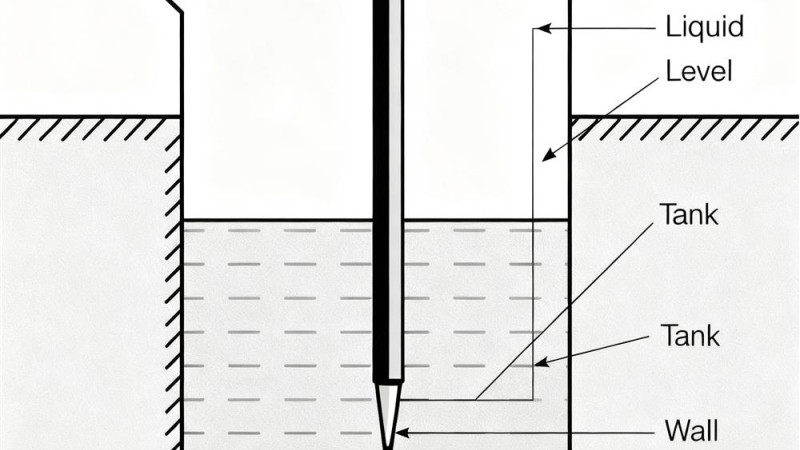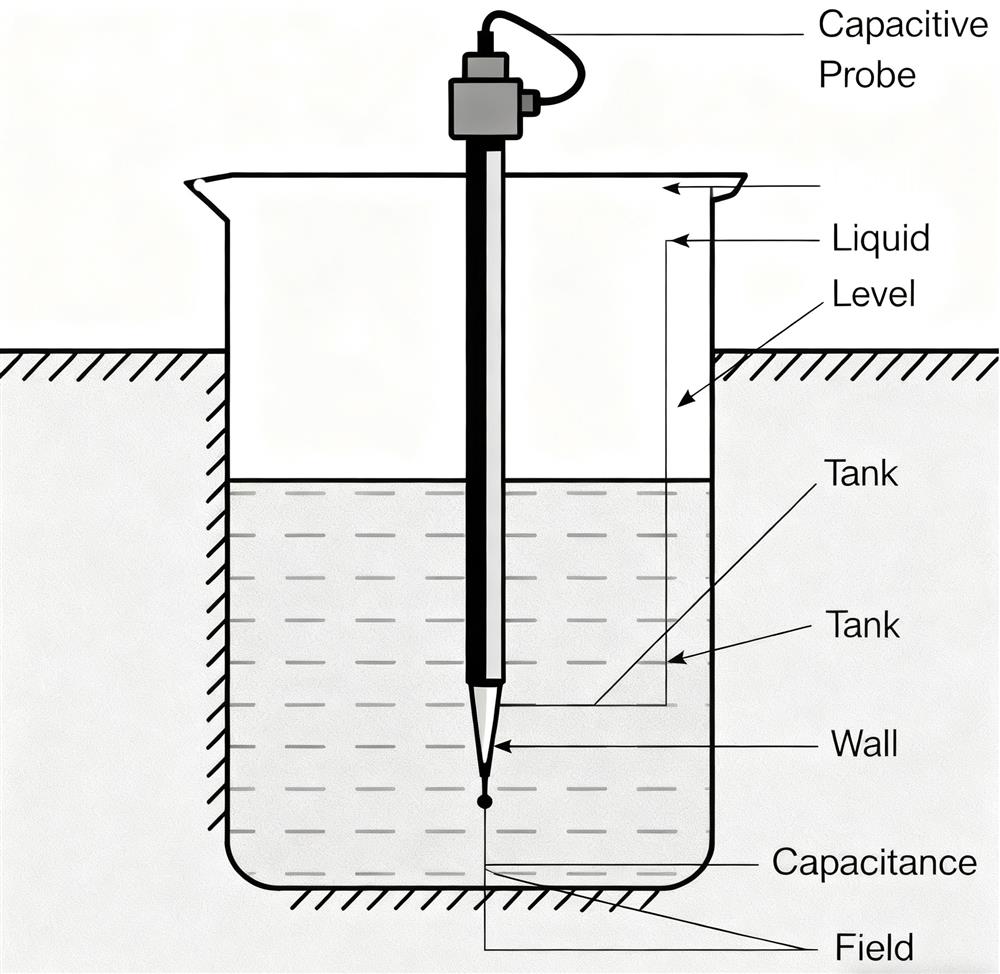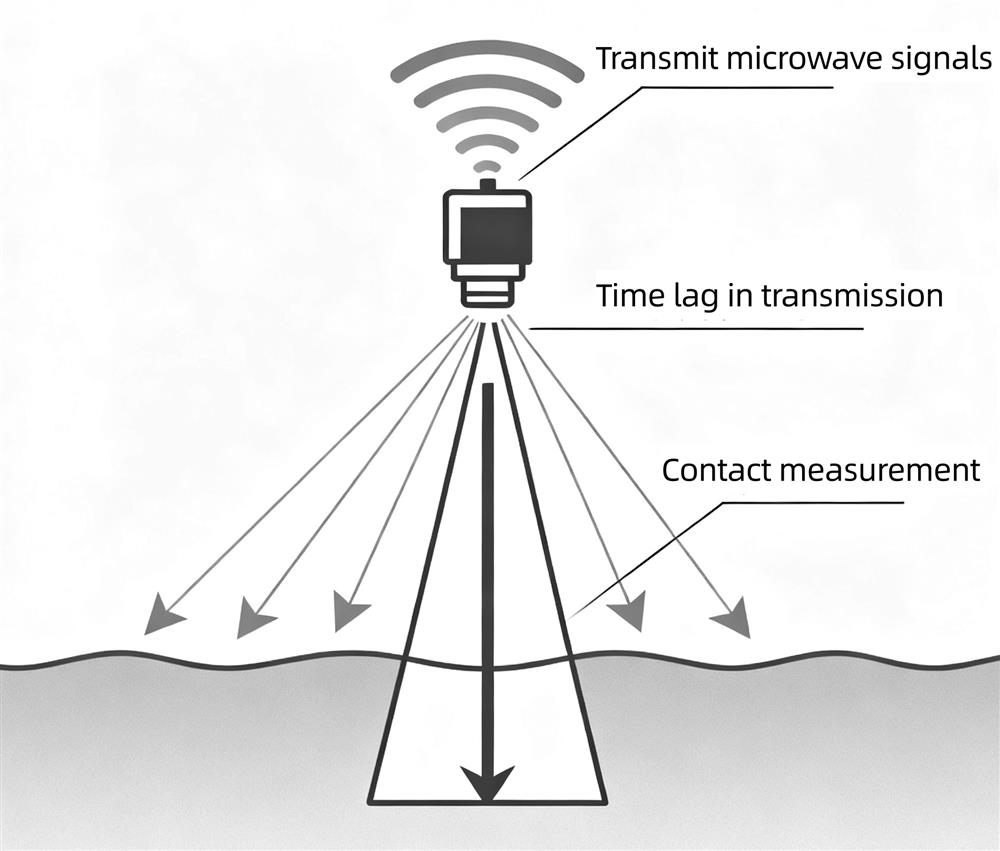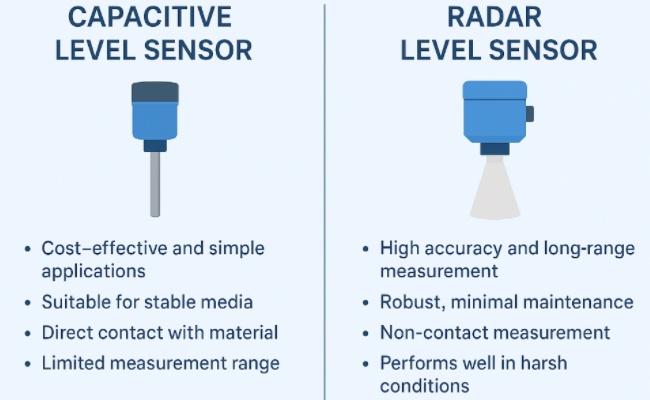
In modern industrial automation, precise level measurement is a cornerstone of process control and efficiency. However, the diverse range of available sensor technologies can make selection a complex task. Among the leading options, capacitive and radar level sensors each offer distinct advantages. This article delves into a detailed comparison to guide you toward the optimal choice for your application.
Demystifying the Working Principle of Capacitive Level Sensors
Capacitive level sensors operate on the principle of detecting changes in capacitance. The core components form a capacitor: the sensor probe acts as one electrode, while the tank wall or a reference electrode serves as the other. The key operational points are:
Measurement Basis: The system measures the capacitance change caused by the material level variation between these electrodes.
Contact Requirement: This is a direct-contact technology, requiring the sensor to be in contact with the medium.
Key Dependency: Measurement accuracy is highly dependent on the medium having a stable dielectric constant (εr).
Consequently, these sensors deliver reliable performance for conductive liquids like water and non-conductive liquids with a consistent dielectric constant.

Radar level sensor: employs a fundamentally different working principle. They emit microwave signals toward the liquid surface and accurately calculate the liquid level by measuring the time difference between signal transmission and return. This non-contact measurement method allows the sensor to perform without touching the medium, effectively avoiding issues such as medium contamination, corrosion, or adhesion. The propagation characteristics of radar waves make them nearly immune to environmental factors like medium density, viscosity, temperature, pressure, steam, and dust, ensuring stable and reliable measurement even in complex working conditions.

Performance Comparison
Measurement Range and Depth
Capacitive: Typically suited for short to medium-range measurements. Performance decreases in very deep tanks or silos due to signal attenuation.
Radar: Excel in long-range measurements, often exceeding 30–80 meters depending on model. Ideal for tall vessels, silos, and outdoor tanks.
Accuracy and Repeatability
Capacitive: Provides good accuracy when the dielectric constant of the medium is stable. However, accuracy can drift if process conditions vary. Repeatability is solid under controlled conditions.
Radar: Highly accurate, with errors often within a few millimeters. Accuracy is maintained regardless of changes in temperature, pressure, vapor, or turbulence.
Response Time
Capacitive: Fast response time since changes in capacitance are detected almost instantly. Suitable for applications requiring quick detection of rising or falling levels.
Radar: Also provides quick response, but advanced signal processing can slightly delay output compared to capacitive sensors. Still suitable for most dynamic processes.
Media Compatibility
Capacitive: Performed well with liquids and some powders, provided they have sufficient dielectric contrast with air. May struggle with hydrocarbons, oils, or media with low permittivity.
Radar: Worked across almost all liquids, slurries, and bulk solids, regardless of dielectric constant. Handles foams, vapors, dust, and even turbulent surfaces with consistent performance.
Environmental Robustness
Capacitive: Sensitive to coating, buildup, and contamination on probes, which can cause false readings or require frequent cleaning. Performance is influenced by temperature and pressure changes.
Radar: Highly robust in harsh environments. Resistant to steam, vapor, foam, and dust. Non-contact versions have no direct contact with media, reducing contamination and wear.
Signal Reliability
Capacitive: The signal may weaken or drift when the dielectric constant of the medium changes. Requires careful calibration and compensation for changing conditions.
Radar: Stable and reliable signals due to advanced microwave processing. Multiple frequency options help minimize interference and optimize reflection from different surfaces.
Maintenance and Lifespan
Capacitive: Probes require periodic cleaning, especially in sticky or corrosive media. Over time, coatings can degrade performance.
Radar: Non-contact radar requires minimal maintenance. Longer lifespan due to reduced exposure to harsh materials.
| Feature | Capacitive Sensors | Radar Sensors |
| Cost | Cost-effective | Higher cost upfront |
| Structure | Simple design | More complex system |
| Response Time | Very fast for stable media | Fast, slightly slower due to processing |
| Range | Limited to short/medium | Long range, ideal for tall tanks |
| Accuracy | Good under stable conditions | High accuracy, unaffected by environment |
| Environmental Tolerance | Sensitive to buildup, temp, pressure | Robust against steam, dust, and foam |
| Maintenance | Needs probe cleaning | Minimal maintenance |
| Best Use Case | Small tanks, stable liquids, budget projects | Harsh environments, long tanks, precision needs |
How to Choose?
Selecting the right level sensor requires balancing media properties, operating conditions, and accuracy needs.
- Media compatibility: Capacitive sensors require stable dielectric constants and suit water or oils. Radar sensors perform independently of media characteristics, ideal for adhesive or corrosive liquids.
- Work environment: Radar is preferred in challenging conditions like steam or dust. Capacitive sensors offer cost efficiency in stable settings with maintenance access.
- Accuracy and cost: Radar ensures ±1mm precision for custody transfer. Capacitive sensors provide economical monitoring for non-critical applications, factoring in calibration needs.

Making the Informed Choice
In summary, both capacitive and radar sensors are vital tools in the level measurement portfolio, but they serve distinct purposes. The optimal choice hinges on your specific application requirements.
| Feature | Capacitive Sensor | Radar Sensor |
|---|---|---|
| Cost | Cost-effective | Higher investment |
| Principle | Contact (relies on dielectric constant) | Non-contact |
| Accuracy | Good for stable media | Superior, especially over long ranges |
| Ideal Use Case | Stable, non-coating liquids & granules | Harsh conditions, long-range, vapors |
By carefully evaluating factors such as media properties, environmental conditions, and range requirements, you can select the most efficient and reliable technology. Explore our comprehensive range of level sensors at Rddlz.com to find the perfect model tailored to your unique process needs.

3 Comment(s)
1
1
1
1
1
1
1
Leave a comment